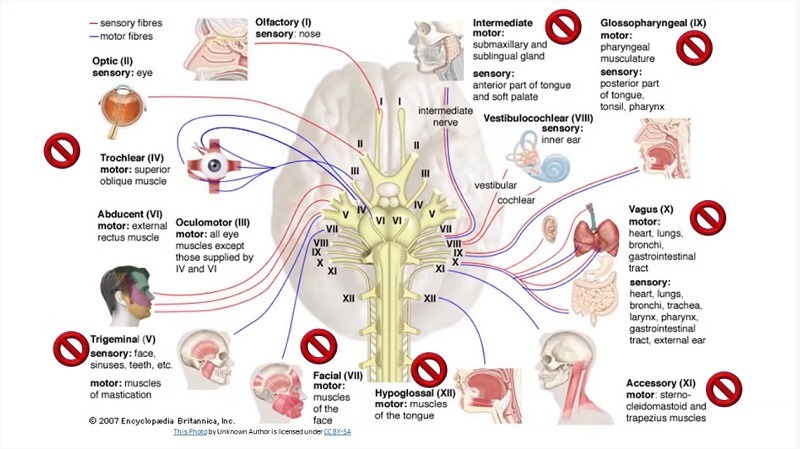
Written by Claire Dunkley from Cluzie Clinic
When we think about our human senses, we commonly think of five: taste, smell, sight, hearing and touch. If we want to be really woo woo, we may consider intuition as a sense as well.
These five senses are very tangible ways in which we assess our environment. Our brains take in this information, process it and assess how we need to respond … VERY QUICKLY! The sensory input is computed by processing a stimulus, triggering a reflex and thus then giving rise to an action.
In our head, we have 12 cranial nerves, each one is its own direct link into our brain with crosslinking. What is interesting, is our ideas of our five senses, four of the five have a cranial nerve that is attributed solely to that sense.
So that begs the question, what ‘sense’ are the other eight cranial nerves? If each cranial nerve has a specific ‘sense’ to be able to assess all sensory input, but we only categorise four currently, what are the other ones that we no longer pay any conscious attention to?
This diagram shows the 12 cranial nerves and what is currently known about each nerve ‘sense’.

I, II, VII* and VIII are related to what we commonly know as smell, sight, taste and hearing respectively.
* The VII cranial nerve has been reduced down to only being attributed to taste however also covers emotions and tears as well. As a society, we undervalue the sensory input of ‘tears’ where we apologise when we cry … “Oh I’m so sorry I am crying, I just can’t stop …”. However, imagine if we valued the input that our emotions or our tears were telling us and helped to direct our reactions – what would life look like?
III – Range Finding: The third cranial nerve is also attributed to what the eye can compute and tell us however in the form of measuring range within distances through the use of triangulation. This was highly important in the past when an object viewed far away needed to be assessed for whether the action to be taken was to run away from / run towards / or do nothing – not dangerous or exciting at all. Since the Industrial era, we have reduced our need for this sense as we are inside buildings all day long.
Just like a muscle, our ‘senses’ need to be exercised in order to perform better – hence going to the gym to pump iron and get bulging biceps. For our senses, they need to be put in the environment where they get put to use. If we don’t spend time outside looking at objects far in the distance, we reduce our range finding sense ability.
IV – Focus: Whilst also attributed with our eyesight, it is not just the twinkling lights but the pattern of those lights. When looking at the stars using a telescope, you can see each star has a cloud around it formed of gas which gives it a shape. Hence the descriptions of the constellation as ‘Orion, the hunter’ for example. By reducing our use of this focus cranial nerve, we no longer can ‘see’ the depth of patterns that our ancestors described in their stories, myths and legends.
V – Facial Expression: How much information do we take in when focusing on another person’s face. How can we instinctively tell a person is lying when we look at their face whether it is a twitch of the eyebrow, pursed lips, not blinking or looking towards the door – all of these inform an action based off the sensory input. When enforced to wear a mask, this reduces our ability to strengthen and use this ‘sense’.
VI – Peripheral Awareness: Also during the industrial age, we reduced our scope of awareness to say that all of the facts can be contained in an A4 page. This reduction impacts our ability to sense all information laterally.
IX – Apprehension: The ninth cranial nerve inputs ‘tension’ and triggers reflexes that respond to the apprehension that is sensed. This is felt in the body by giving you a headache!
X – “Gut Instinct” – Vagus Nerve: This IS our woo woo sense … that feeling that something is just not right “I feel sick to my stomach”. The Vagus Nerve runs from your stomach to your brain and has multiple nerve endings in the gut. This sensory information is an intelligence when we pay attention to what our gut is telling us.
XI – Stress - Accessory Nerve: The sense that is something is wrong in the world and you can feel the stress of whatever is contributing to this.
XII – Speech: The ability to communicate and share big ideas. Previously, when considering big scale ideas like building a skyscraper or flying to the moon, these ideas were collaborated on through the use of speech. In today’s age where communication and opinions are being restricted by business conglomerates unless they are a particular point of view, we are reducing our ability to think up and create big ideas.
Where does this leave us? We have the choice to start consciously exercising all of our 12 ‘senses’ and really listening to our body in what it is telling us.
If you want to learn more about the 12 senses, listen to the master of the information – David Martin. Here is his video on it.



